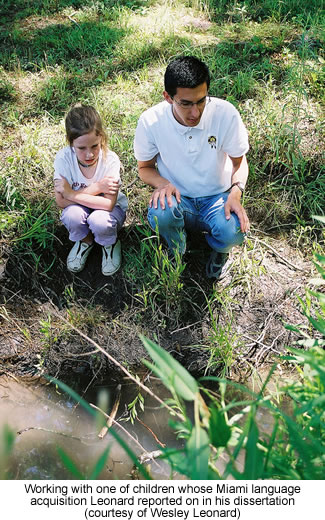 |
Canku Ota
|
 |
|
(Many Paths)
|
||
|
An Online Newsletter
Celebrating Native America
|
||
|
January
2013 - Volume 11 Number 1
|
||
|
|
||
|
Awakening Languages
|
||
|
by Janet Eastman - Ashland
Daily Tidings
|
||
 Dr.
Wesley Leonard is a linguistic anthropologist and associate professor
of Native American Studies at Southern Oregon University. His research
is changing linguistics, and his classes are transforming the way
students perceive and study indigenous languages and cultures. Dr.
Wesley Leonard is a linguistic anthropologist and associate professor
of Native American Studies at Southern Oregon University. His research
is changing linguistics, and his classes are transforming the way
students perceive and study indigenous languages and cultures.
"There is tremendous interest and enthusiasm to learn about Indian language," says Leonard. Some students in his Teaching and Learning Indian Languages course are Native Americans who want to study their own language. Other simply want to learn a grammatically different language or one that is not widely taught. For 8 weeks, students study the language and research words and meanings through dictionaries — "some that are not user friendly." says Leonard. Then they deliver minutes-long monologues or dialogs in the language to the class. "There aren't many opportunities to do that in an academic setting," says Leonard. "This class challenges a common belief that Native American languages have a limited place in contemporary society and are restricted to ceremonies." He says the languages teach students a lot about Native cultures. Students also realize that if U.S. policy had been different, Native languages might be used far more often than they are today. Dr. Leonard is of Miami-Japanese descent. He wears a bolo tie given to him by his grandfather, the late chief of the Miami Tribe of Oklahoma. A golden crane is printed on the tie clasp. The crane is the symbol for his Miami clan and for mystical creatures in Japan, where Leonard's mother was born.
Because of this, academic literature refers to the Miami language as extinct. Thankfully, Dr. Leonard and other scholars collected thousands of historical documents written by missionaries and others in the Miami language. From these legacy documents, phonetic charts, and interviews with "language rememberers" (tribal members who spoke or heard Myaamia), the language has been revived. Leonard terms such languages as "sleeping languages" -- a language without fluent speakers but that existing documentation and can be claimed by heritage people. "I find it damaging to fellow tribal members to be told their language is extinct because it implies the culture is extinct and that Native Americans belong in the past," says Leonard, who grew up in Ohio. Today, children are learning the Myaamia language as their first or second language. Leonard also works with other communities that have sleeping languages."By sharing the Miami story, it gives people a larger sense of hope," he says, "and on a theoretical level, it changes the sleeping language from an imagined category into a more tested one." |
|
|
||
|
|
||
| Canku Ota is a free Newsletter celebrating Native America, its traditions and accomplishments . We do not provide subscriber or visitor names to anyone. Some articles presented in Canku Ota may contain copyright material. We have received appropriate permissions for republishing any articles. Material appearing here is distributed without profit or monetary gain to those who have expressed an interest. This is in accordance with Title 17 U.S.C. Section 107. | ||
|
Canku Ota is a copyright ©
2000 - 2013 of Vicki Williams Barry and Paul Barry.
|
||
 |
 |
|
|
The "Canku
Ota - A Newsletter Celebrating Native America" web site and
its design is the
|
||
|
Copyright ©
1999 - 2013 of Paul C. Barry.
|
||
|
All Rights Reserved.
|
||
 The
Miami tribe were once tens of thousands strong. In 1846, they were
forcibly removed from their ancestral Ohio homelands and sent to
Kansas and Oklahoma. By the early 1900s, Miami children were sent
to Indian boarding schools where their native language was forbidden.
The
Miami tribe were once tens of thousands strong. In 1846, they were
forcibly removed from their ancestral Ohio homelands and sent to
Kansas and Oklahoma. By the early 1900s, Miami children were sent
to Indian boarding schools where their native language was forbidden.